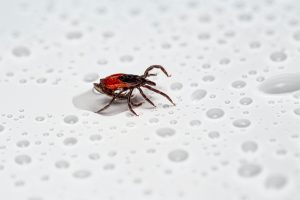12 Ways to Avoid Ticks This Summer
There is still a lot of summer left!
There are more woods and gullies, to explore, amiright? So! We know you have heard all these tips before, but a reminder can’t hurt. Maybe you will learn something new. We did. We had no idea ticks were so small. Such little guys to command such great fear! Here are some good tips for you.
- Avoid areas where ticks live, especially wooded, bushy areas with long grass. Spending time outside camping, gardening, or hunting brings you in close contact with ticks.
- If you do go into the woods or tall grass, try to stick to trails and paths, and wear shoes, long pants tucked into your socks, a long-sleeved shirt, a hat and gloves. Keep your dogs on a leash.
- Use DEET or Permethrin. If you are Team DEET, apply an insect repellent with a 20% or higher concentration of DEET to your skin. If you are Team Permethrin, treat clothing, boots and gear with products containing Permethrin. The difference between the two? Deet repels ticks while Permethrin immobilizes them on contact. The Environmental Protection Agency says that, when used as directed, both are safe.
- When you come in, check your clothing, your body, your children and your pets for ticks. Ticks are often no bigger than the head of a pin, so you might not discover them unless you search carefully.
- Shower as soon as you come indoors. Ticks often remain on your skin for hours before attaching themselves. (What are they doing there? Having a happy hour?) Showering and using a washcloth might remove unattached ticks.
- Wash your clothes in hot water. Cool and warm water may not kill ticks; that’s just a spa day to them.
- If you see a tick, remove it as soon as possible with tweezers. Gently grasp the tick near its head or mouth. Don’t squeeze or crush the tick but pull carefully and steadily. Once you’ve removed the entire tick, dispose of it by putting it in alcohol or flushing it down the toilet and apply antiseptic to the bite area.
- Tick-proof your yard! Clear brush and leaves – that’s where ticks live. Mow your lawn regularly. Stack wood neatly in dry, sunny areas to discourage rodents that carry ticks. Place wood chips or gravel between lawns and wooded areas to keep ticks away from recreational areas. Keep play areas and playground equipment away from shrubs, bushes, and other vegetation. Discourage deer by removing plants that attract deer and construct physical barriers to help discourage deer from entering your yard.
- Consider using a chemical control agent. Tick control chemicals are effective for a homeowner to use or they can be applied by a professional pest control expert.
- Watch for signs of sickness — such as rash or fever — in the days and weeks following the bite. Your risk of getting a tickborne disease depends on many factors, including where you live, the type of tick that bit you, and how long the tick was attached. Be sure to see a health care provider if you become sick after a tick bite, have a rash or a fever.
- Dogs are very susceptible to tick bites and tickborne diseases. Vaccines are not available for most of the tickborne diseases that dogs can get, and they don’t keep the dogs from bringing ticks into your home. For these reasons, it’s important to use a tick preventive product on your dog. Talk to your veterinarian about the best tick prevention product for your dog.
- Don’t assume you’re immune. You can get Lyme disease more than once.

Photo by Erik Karits on Erik Karits
Bonus: We have not checked this out, but apparently the Center for Disease Control has a Tick Bite Data Tracker which will help you find out when people in your part of the country are at higher risk of getting bitten by ticks.
Stay safe this summer, Friends!


